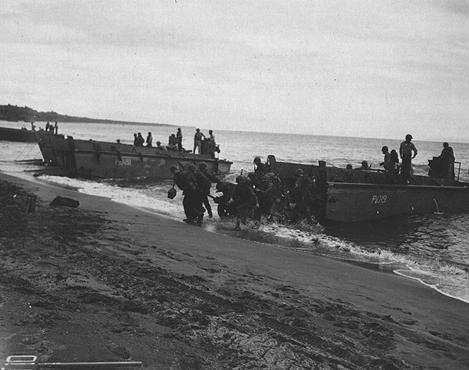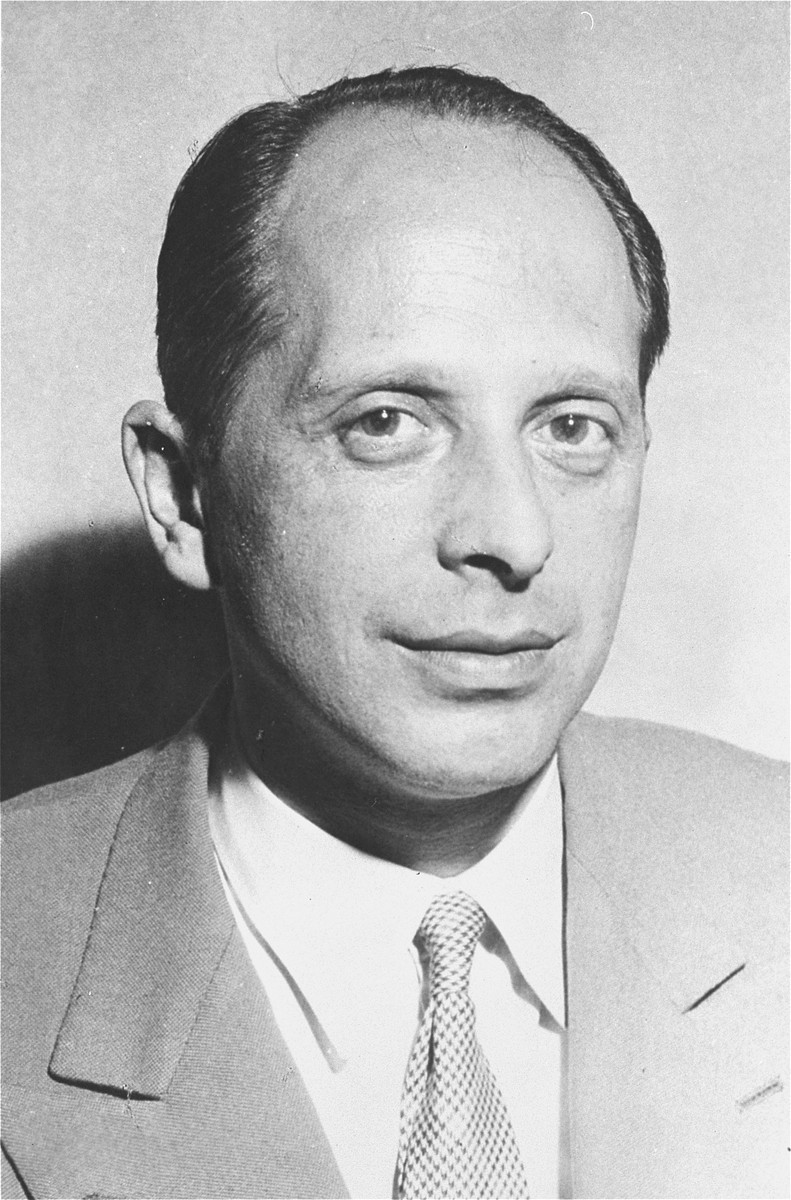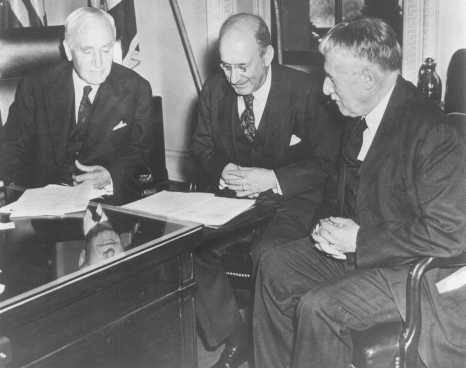
The United States and the Holocaust, 1942–45
The United States entered World War II in December 1941, after Japan attacked Pearl Harbor. By 1942, Americans were increasingly aware that the Nazi regime was perpetrating the mass murder of European Jews. Large-scale rescue of the victims of Nazi Germany and its collaborators was impossible by this time. The US government took limited action that saved tens of thousands of lives.
Key Facts
-
1
In 1942, the US State Department confirmed that Nazi Germany planned to murder all the Jews in Europe. This information was reported widely in the American press.
-
2
There was a fast growing humanitarian and refugee crisis across Europe during World War II. Nevertheless, the United States and the other Allied forces prioritized the military defeat of Nazi Germany and the other Axis powers.
-
3
In January 1944, President Franklin Roosevelt established the War Refugee Board to carry out a new US policy of proactive rescue and relief for Nazi victims. Its efforts saved tens of thousands of lives.
Introduction
The United States entered World War II in December 1941, after Japan attacked Pearl Harbor. For almost four years, the American people—soldiers and civilians alike—made considerable sacrifices to defeat Nazism, from serving in the military to supporting the war effort at home. By 1942, the American press carried a number of reports about the ongoing mass murder of Jews. The US government confirmed this information in late 1942. Although the United States could have done more to aid the victims of Nazi Germany and its collaborators, large-scale rescue was impossible by the time the United States entered the war. In January 1944, President Roosevelt created the War Refugee Board, which took significant measures to aid Jews and other victims.
Americans at War
On December 7, 1941, Japan launched a surprise aerial assault on the US Pacific fleet at Pearl Harbor, Hawaii. Two days later, President Franklin D. Roosevelt told Americans:
“We are now in this war. We are all in it—all the way. Every single man, woman, and child is a partner in the most tremendous undertaking of our American history.”
Over the next year, the US military doubled in size to four million service members and trained continually to prepare for combat. During most of 1942, the US Navy fought Japan in the Pacific, while ground troops prepared for battle in North Africa and Europe. On the homefront, millions of women entered the workforce—many for the first time—and Americans were forced to adjust to rationing of food and consumer goods.
Even as the United States went to war to defend democracy abroad, the government violated the rights and limited the opportunities of its own minority citizens.
In February 1942, two months after the attack at Pearl Harbor, President Roosevelt signed an executive order permitting the government to take “every possible protection against espionage and against sabotage.” Citing national security concerns, the US government used that order to relocate more than 110,000 Americans of Japanese ancestry—at least two-thirds of whom were American citizens—to ten camps across seven states. Japanese American men in these camps were not permitted to enlist in the US military until 1943. The 442nd regimental combat team, made up entirely of Japanese Americans, became the most highly decorated military unit of that size in American history and liberated a subcamp of Dachau.
Throughout World War II, the US Army remained segregated by race. The National Association for the Advancement of Colored People (NAACP) showcased the dedication of African American troops as part of its “Double-V” campaign, advocating victory against fascism abroad, and against racism at home. The Army remained segregated until 1948, three years after the end of World War II.
News of the "Final Solution"

On November 25, 1942, many American newspapers published reports that 2 million Jews already had been murdered. The World Jewish Congress’s representative in Switzerland, Gerhart Riegner, had tried to report this information to his organization’s president, Rabbi Stephen Wise, in August 1942, sending a message through the US State Department. State Department officials at first tried to block Riegner’s report from reaching Rabbi Wise. They claimed that the planned murder of European Jews was merely a “war rumor.” Yet after investigating Riegner’s report over the next three months, State Department officials verified the news of the Nazi regime’s plan, and, according to Wise, authorized him to inform the American public.
In response to this news, Jewish communities in many Allied nations held rallies and vigils, and declared Wednesday, December 2, 1942, to be an international day of mourning. The United States, Great Britain, the Soviet Union, and nine Allied governments released a “Declaration on Atrocities” on December 17, 1942. This declaration condemned the “bloody cruelties” and “cold-blooded extermination” of Europe’s Jews and vowed that the Allies would punish war criminals after the fighting stopped. It made no promise to initiate rescue efforts.
Public Pressure for Action
As additional details about the ongoing Nazi mass murder of European Jews trickled out to the public in 1943, American Jews remained divided about how much pressure to exert on the federal government to take action to rescue Jews. Some worried that appeals on behalf of Jewish victims would result in an antisemitic backlash in the United States. Others insisted that public pressure would be the only way to spark government action to rescue victims before the war ended. A few tried both tactics: Rabbi Stephen Wise sponsored a massive pro-rescue rally in Madison Square Garden, and also lobbied President Roosevelt privately to assist Jews.
The State Department and British Foreign Office officials tried to address the mounting public pressure for an Allied rescue effort by holding the Bermuda Conference in April 1943. Delegates from both countries met in Bermuda to formulate plans to aid Jews, though they were given strict instructions that limited any real possibility of mass rescue. When the conference ended with no publicized plan, rescue advocates only grew more frustrated. The American press criticized the conference as empty posturing on the part of both nations.
Activist Peter Bergson and his Emergency Committee to Save the Jewish People of Europe embarked on a propaganda campaign in the United States to raise awareness of the plight of European Jews. Bergson hoped relentless pressure from his committee would lead to government-sponsored rescue efforts. Bergson organized rallies and marches, staged an elaborate pageant titled "We Will Never Die," and placed full-page newspaper ads accusing the Roosevelt administration of inaction.

The Roosevelt administration also received pleas for action from individuals. In 1942, Jan Karski, a member of the Polish underground resistance, witnessed the horrors suffered by Jews both in the Warsaw Ghetto and in a transit camp near a Jewish ghetto in German-occupied Poland. Karski met President Franklin D. Roosevelt at the White House on July 28, 1943, and told the president about the dire situation Jews faced under the Nazi regime. Karski later recalled that FDR promised the Allies would win the war but that the president made no mention of rescuing Jews.
In November 1943, Bergson’s Emergency Committee persuaded members of Congress to introduce a resolution intended to pressure President Roosevelt to appoint a commission responsible for rescuing Jews. Assistant Secretary of State Breckinridge Long testified before Congress in hearings on the resolution, claiming that the State Department had been actively assisting Jewish refugees. Long said that the United States had admitted 580,000 refugees since 1933. Refugee advocates quickly pointed out that Long’s claims were untrue.
Treasury Department Investigation
In December 1943, the Treasury Department investigated lengthy State Department delays in approving World Jewish Congress relief funds intended for Jews in France and Romania. Treasury staff discovered that Assistant Secretary of State Breckinridge Long had ordered the US legation in Switzerland to stop sending information about the murder of Jews to the United States, specifically to block details provided by Gerhart Riegner.
Secretary of the Treasury Henry Morgenthau Jr. decided to take these findings to President Roosevelt after he read his staff’s report, titled “Personal Report to the Secretary on the Acquiescence of this Government in the Murder of the Jews.” On January 16, 1944, Morgenthau and two members of his staff met with the president, who agreed to remove responsibility for refugee and rescue activities from the State Department.
Roosevelt signed an executive order on January 22, 1944, creating the War Refugee Board (WRB). Headed by the Secretaries of Treasury, State, and War, the WRB was responsible for carrying out the new US policy for the rescue and relief of Jews and other minorities persecuted by Nazi Germany and its collaborators.
The War Refugee Board

The War Refugee Board was an independent government agency which existed from January 1944 to September 1945. Though the US government prevented the WRB from diverting any military resources towards rescue, its efforts saved tens of thousands of Jews and other victims of Nazi persecution and assisted hundreds of thousands more in the last year and a half of World War II.
The WRB’s first director, John Pehle, and most of its staff were Treasury Department employees, though some private citizens and relief organization representatives joined its efforts. Its administrative and secret rescue operations funds came from Roosevelt’s emergency fund and through congressional appropriations. The WRB streamlined bureaucratic paperwork, eased regulations, and lent government communication channels to assist private organizations—Jewish and non-Jewish—that wanted to send relief funds to Europe.
The WRB launched a propaganda campaign to warn perpetrators that they would face legal punishments after the war and negotiated with neutral nations to allow more refugees to cross their borders. It opened the Fort Ontario Emergency Refugee Shelter in Oswego, New York, bringing 982 refugees, most of whom were Jewish, from Allied-occupied Italy to the United States. After the Nazi regime’s invasion of Hungary in March 1944, the WRB worked with the Swedish government to place Swedish businessman Raoul Wallenberg in Budapest to protect Jews. As more information about the deportations from Hungary to Auschwitz reached the United States, the WRB forwarded requests to bomb the rail lines, or the camp itself, to the War Department, which rejected the proposals. It released details about the operations of the Auschwitz concentration camp to the American public and supported secret ransom negotiations with Nazi officials to save Jewish lives. The WRB also sent 300,000 food packages, disguised in Red Cross boxes, into concentration camps in the final weeks of the war.
Liberation
As Allied troops moved into Europe in a series of offensives against Nazi Germany, they encountered concentration camps, mass graves, and numerous other sites of Nazi crimes. In July 1944, Soviet forces were the first to overrun a major Nazi concentration camp, Lublin/Majdanek, that had been established in German-occupied Poland. On January 27, 1945, Soviet troops liberated Auschwitz. The US military did not participate in the liberation of any extermination camps in Nazi-occupied Poland.
Though the liberation of Nazi camps was not a primary military objective, American soldiers advancing into the interior of Germany in the spring of 1945 liberated major concentration camps, including Buchenwald, Dachau, and Mauthausen, as well as hundreds of subcamps. They also encountered and liberated prisoners on forced marches and those who had been abandoned by their Nazi captors.
After touring the Ohrdruf concentration camp on April 12, 1945, General Dwight D. Eisenhower sent a telegram to Washington:
“The things I saw beggar description…The visual evidence and the verbal testimony of starvation, cruelty and bestiality were…overpowering…I made the visit deliberately in order to be in position to give firsthand evidence of these things if ever, in the future, there develops a tendency to charge these allegations merely to propaganda.”
Eisenhower encouraged American soldiers in the vicinity of a concentration camp to tour the site, take photographs, and write letters to their families in the United States describing what they had seen. He also arranged for delegations of journalists and members of Congress to tour the recently liberated camps.
Displaced Persons
When World War II ended in Europe in May 1945, more than two million Europeans were displaced, including 250,000 Jews. American, Soviet, British, and French troops occupying German territory set up displaced persons (DP) camps to house Holocaust survivors and other DPs. In the first few months after the war ended, the camps were places of suffering and hunger. Jewish survivors were often held in the same camps with German civilians, or even with Nazi perpetrators.
In the summer of 1945, President Harry Truman asked former US immigration commissioner Earl Harrison to tour the DP camps. Harrison was shocked by what he found and informed Truman: “We appear to be treating the Jews as the Nazis had treated them, except that we do not exterminate them.” Based on Harrison’s report, the United States established separate camps for Jewish DPs.
President Truman issued the Truman Directive on December 22, 1945.
This directive instructed State Department consular officials to give preference to DPs within the existing immigration quotas. The existing immigration quotas had been in place since Congress passed the Johnson-Reed Act in 1924. Truman did not believe that Congress would be willing to expand the existing quotas, even in response to the clear humanitarian need.
In 1948, Congress passed the Displaced Persons Act, authorizing 200,000 displaced persons to enter the United States without being counted against the immigration quotas. The act did not include any special provisions for Jewish DPs.
Between 1945 and 1952, more than 80,000 Jewish Holocaust survivors immigrated to the United States under the terms of the DP act, many with the aid of Jewish relief organizations.
Critical Thinking Questions
What could the international community, including the United States, have done to stop the rise of Nazism in Europe and its assault on Europe’s Jews?
Examine the motives, pressures, and fears that shaped Americans’ responses to Nazism, war, and genocide.
How did wartime propaganda shape the way Americans understood Nazism as a direct threat to their own safety and to the security of the United States

